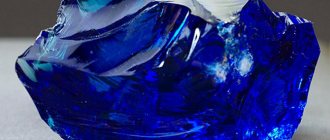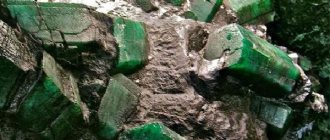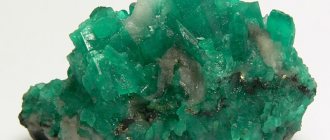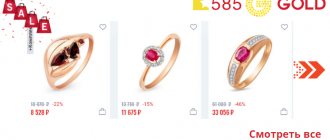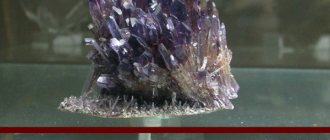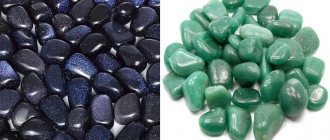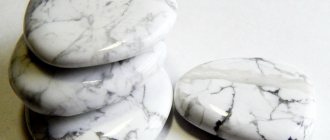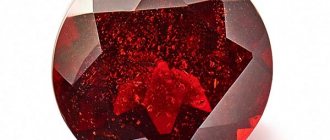A lady finds herself in a difficult situation when she finds herself in a store hoping to choose some jewelry for herself. The stones sparkle and shimmer, the price tags are confusing, the tags do not clarify anything - in general, the situation is almost hopeless. Sellers are ready, in principle, to answer any question, but what to ask is unknown. You can’t ask a nice girl: “Is that green one over there a good stone? Isn’t it a fake?”
Precious stones, transparent and hard, are rare in nature and therefore are expensive. These include diamond, natural pearl, sapphire, emerald and ruby.
However, diamond occupies a special place among them. It combines exceptional hardness, high light refraction and high gloss.
Diamond
Diamonds are made up of pure carbon atoms that exist deep underground, subjected to intense heat and pressure over billions of years.
What can it be confused with?
The greatest similarity is found in cubic zirconia (colorless zircon created by laboratory synthesis at the Physical Institute of the P.N. Lebedev Academy of Sciences). Although they are very similar in appearance, if you look closely, cubic zirconia gives less colorful highlights. Beryl, sapphire, topaz, and quartz are also passed off as diamonds.
Price
Diamonds are piece goods. A high-quality diamond weighing 1 g costs hundreds of thousands of rubles.
Tips for choosing
Let's try to understand the mineral according to the parameters indicated on the price tag.
The cost of any gemstone is made up of four factors: weight, shape, color and quality.
Weight is measured in carats (in ancient times, this word was used to describe special seeds with which the size of a pebble was compared). 1 carat is equal to 0.2 g. The price per carat increases with the weight of the diamond. A particularly sharp jump in price is observed at the 1-carat mark, when the price of identical stones weighing 0.99 carats and 1 carat differs by approximately 1.3 times, since it is believed that a “real” diamond starts at 1 carat. Depending on their weight, diamonds are divided into small (up to 0.29 carats), medium (from 0.30 to 0.99 carats) and large (more than 1 carat). If the diamond is too small, its mass is measured in “points”, which are 0.01 of the carat, that is, only 2 mg.
Form. This is the type of cut: round, oval, etc. This determines how the stone “plays” and glows. Round shape (Kr) is the most common option. Ovals and hearts are cut less frequently and are cheaper. The cut can be simplified, with 17 facets (Kr-17) (for small stones) and complex - with 57 and 58 facets (Kr-57). Another point that influences the evaluation of a stone is the quality of the cut (symmetry, polishing, etc.), evaluated by the letters “A”, “B”, “C”, “D”, where the first one denotes the highest class.
Color. Due to the peculiarities of the diamond formation process, only a few specimens are truly colorless stones. The more colorless a “white” diamond is, the higher its value. These rules do not apply to fancy colored diamonds. Such diamonds come in blue, pink, red, yellow, and green. They are very rare, and their cost is several times higher than the cost of “white” diamonds. Diamonds are classified into color groups from colorless with a gradual increase in saturation to yellow, brown, and gray shades. The number of color groups depends on the weight. Small Kr-17 diamonds are classified into 4 color groups (1 – colorless stones). Small Kr-57 diamonds are classified into 7 color groups (1 - colorless stones). Medium and large diamonds are classified into 9 main color groups (1 - colorless stones).
Purity. Diamonds are classified into clarity groups depending on the presence of internal characteristics (inclusions, cracks, surface defects, the elimination of which will lead to significant weight loss), their quantity, location and color (characteristics visible through a 10x magnifying glass are taken into account). Although these shortcomings make the product unique, their presence still makes the product cheaper. The quantity depends on the weight. Thus, small Kr-17 diamonds are classified into 6 purity groups, and small Kr-57 diamonds into 9 groups. For medium and large stones there are 12 purity groups. The relationship between color and clarity is usually expressed as a fraction, with the larger the numerator and denominator, the lower the quality of the stone. For example, a diamond with a characteristic of 3/3 is considered good, but a fraction of 9/12 indicates a very low quality of the stone.
We translate from jewelry
The “coding” of a diamond’s quality looks something like this: Kr57A-0.47-3/5. Translation from jewelry:
- Kr57A - has a round cut shape (Kr) with 57 facets (57) of very high quality (A).
- 0.47 - the second number indicates the size of the stone. Weighs 0.47 carats, that is, medium in weight.
- 3 - the penultimate number on the label indicates the degree to which the color of the stone differs from white (transparent).
- 5 - the last digit indicates the class of “purity” or quality of the stone. Our sample has few foreign inclusions.
Summary
An ideal diamond weighs from 1 carat, round grade A cut with 57 facets, colorless, pink or blue, with a color/quality ratio of 1/1 to 3/3.
Medicinal properties
The natural mineral has a complex effect on the body:
- regulates blood pressure;
- soothes headaches and migraines (earrings are especially suitable for this);
- treats arthritis, arthrosis;
- improves the functioning of the gastrointestinal tract;
- heals the genitourinary system;
- has a beneficial effect on women's health;
- normalizes hormonal levels;
- calms the psyche.
This is a bactericidal mineral. The water in which it lay overnight can be drunk without boiling or washed with it for skin problems.
If you apply emerald to your eyes for 15–20 minutes, your vision will improve.
The healing properties of a pristine stone are stronger than a cut one.
Pearl
Natural pearls are formed in the body of an oyster if some foreign body, such as a grain of sand, gets there. The mollusk tries to get rid of it by secreting nacre, which envelops the alien, trying to neutralize its activity. The longer the pearl remains in the oyster's body, the thicker the layer of nacre around it will be. This creates a beautiful shiny gemstone - a pearl.
Natural pearls belong to the category of the rarest and most expensive precious stones. Pearls are not processed by jewelers - they are used in their original form.
What can be confused with
Nowadays, most pearls sold in stores are cultured specimens, grown with the help of humans (a bead is placed in an oyster, after which the pearl formation process continues in the same way as in nature). It is believed that cultured pearls have the same properties as natural pearls. The main difference between natural and cultured pearls is that cultured pearls are harvested much earlier than natural ones, and therefore the layer of nacre on them is very thin.
Price
The price of the final product will depend on the color, growing conditions (sea or river water), thickness of the pearlescent layer, surface gloss, size and shape. As the size increases, the price increases unevenly: a 9 mm pearl costs twice as much as an 8.5 mm pearl. At the same time, river pearls are traditionally valued less than sea pearls. There are no perfectly round pearls, so rounded ones are valued more than crooked ones, but non-standard specimens shaped like snails, for example, are also not cheap. Naturally colored pearls cost more than white pearls, while artificially colored pearls cost less. White and pink pearls are most valued, followed by gold (champagne) and black (Tahitian).
Color
Pale pink, silver, yellowish, light green, white, black, rose red. Sizes range from microscopic to a pigeon egg.
Tips for choosing
If you decide to purchase pearls, compare the quality of what is offered in stores. Take a closer look at the product as a whole: the shine is good, but the roundness is not important; shine and color are normal, but the surface is uneven; The shape is good, but there is no harmony among the pearls in the string.
Place the pearls on your neck or face and make sure their color matches your skin and hair color. Ask if the color is natural. Freshwater pearls are easy to distinguish from sea pearls: they are small and shaped like crooked pearl grains.
Summary
The ideal pearl is natural, marine, shiny and smooth to the touch, without potholes or depressions, round in shape, large in size, white, pink or gold in color.
Physicochemical characteristics
Emerald is a green variety of beryl. Occasionally complemented by blue or yellowish tint. First class gem.
It is formed as a result of the destructive effects of hot thermal spring water on granite rocks.
At temperatures above 700°C, the color of the emerald may disappear.
Description of the standard quality stone: a transparent mineral the color of green grass.
| Formula | Be3Al2Si6O18 |
| Color | Green, yellowish green |
| Shine | Glass |
| Transparency | Transparent, translucent |
| Hardness | 7,5—8,0 |
| Cleavage | Imperfect |
| Kink | Conchoidal, uneven |
| Density | 2.69—2.78 g/cm³ |
Sapphire
Sapphire is known in the mineral world as corundum, whose crystal structure is composed of aluminum oxide. On the hardness scale, sapphire is the hardest gemstone after diamond.
Color
Rare stones of rich cornflower blue color are considered the most valuable. More often there are simply blue, green, yellow, white, pink and brown stones.
What can be confused with
Often the role of sapphire is painted cubic zirconia.
Tips for choosing
The origin of a sapphire greatly influences its value. The homeland of the best sapphires is Kashmir. The color of these stones is cornflower blue. In addition, Kashmir sapphires retain color under artificial light, which is rare for this crystal.
Price
Natural sapphires are very rare and expensive. The purer the blue color of natural sapphire, the higher the price. Darker or paler stones have less value. The price is also affected by the brightness and cut of the stone and the carat weight. The best quality sapphire is one whose purity is visible to the eye, and some inclusions are detectable under a magnifying glass. Sapphires weighing up to 2 carats are more common, but stones from 5 to 10 carats are also found.
However, a gemological3 certificate confirming that the mineral was mined in Kashmir does not yet guarantee its high quality. Burmese sapphires can also be of excellent quality. Sapphires from Sri Lanka are usually paler. The darkest and therefore cheapest sapphires are mined in Australia.
Summary
It is better to look for a sapphire from Kashmir, pure cornflower blue in color, with a good cut, weighing several carats, the inclusions of which should not be visible to the naked eye.
Blood Ruby
Ruby and sapphire have been known to mankind since the Bronze Age. Due to its beauty and uniqueness, the ruby was indispensable in decorating objects of power of medieval kings, high-ranking church officials and wealthy people.
The properties of the mineral are unique. It has a hardness rating of 9 on the Mohs scale, second only to diamonds. Classic rubies are blood-red in color, but purple, pink, and blue are also found in nature. Only a number of countries can boast of crystal mining - Vietnam, Sri Lanka, India and Burma. Occasionally, the mineral is found in Tanzania, Thailand, Kenya and Tajikistan. Stones mined in Burma are considered standard. They have a shade called “pigeon blood” and a pronounced dispersion.
Today, ruby has not lost its significance. In addition, it has found application in the metalworking industry and the manufacture of high-quality wristwatch mechanisms.
It is worth mentioning that at the beginning of the twentieth century, scientists learned to synthesize ruby. Artificial rubies are very similar to real ones, and scammers take advantage of this, so when buying a ruby, you must show the stone to a specialist.
Ruby
Emerald
Emerald is one of the most revered and expensive gemstones. The stone belongs to the beryllium genus, whose crystal structure consists of aluminum and beryllium. Unlike other green stones, it retains its color under artificial light.
Most natural emeralds have cracks and internal defects visible to the eye, and uneven coloring.
Price
The brighter the green, the higher the cost. Unlike a diamond, a beautifully colored emerald does not lose much in value if it contains inclusions. Natural emeralds of the highest quality weighing more than 2 carats are very rare and very expensive.
What can be confused with
A stone that is too pale in color may not be an emerald, but ordinary beryl or inexpensive fluorite. You can distinguish natural emeralds from synthetic ones based on the fact that most natural emeralds are imperfect, have cracks, and are opaque in places. Perfect dark green and perfectly transparent emeralds will most likely turn out to be high-quality synthetics.
Color
There are five types of emeralds: dark green, normal green, medium green, light green, light green. The most valuable are emeralds, the color of which is close to the color of dill.
Tips for choosing
It is good that the emerald passes the examination of a gemological laboratory.
When purchasing, give preference, if possible, to a larger stone; all its play is most noticeable in it.
Summary
It is most pleasant to own a stone of 1 carat or more, always with inclusions that will guarantee its authenticity. The cut should be neat, the edges without jagged edges or roughness. The color is rich green, close to the color of dill. A conclusion from a gemological laboratory would also be useful.
History and origin
The magical emerald was known throughout the ancient world. For the Egyptians, it was a symbol of the patroness of motherhood and femininity, the goddess Isis . Emeralds were used by representatives of the upper castes and the wives of high priests. Not far from Aswan were the famous emerald mines of the Egyptian queen Cleopatra.
Emerald
This is the third gem on the breastplate of the high priest of Judah.
Stones such as emerald were a profitable investment for the Babylonian elite. The Greeks called it the stone of radiance. Arab sheikhs collected piles of green gems of impeccable quality.
In the Islamic world, the magical properties of natural emerald made it the main stone of adherents of occult practices.
For Christians, emerald and the meaning of the stone evoke mixed feelings. According to the Old Testament, an emerald fell from Lucifer's helmet when he was banished to earth. Therefore, this is the embodiment of the forces of darkness. But the Holy Grail is made from it, which means it is a light stone.
In Persia, the concept of “emerald” meant “green stone”. In Rus', the gem was known as emerald; in the English-speaking world, the mineral is called emerald.
Europe became acquainted with the gem in the 16th century: conquistadors returning from America told about the deposits of Colombia. Soon the Old World was overwhelmed by a flood of stones captured from the Indians. In Russia, the Ural emerald deposits were discovered in 1831 by Maxim Kozhevnikov and the commander of the Yekaterinburg lapidary factory, Yakov Kokovin.
Geologists believe that as a stone, emerald is not yet “ripe”: its hardness increases.
In modern Russia, the value of stone as a currency value is legally defined.
How to wear and care
Emerald is durable and difficult to damage at home. However, it does not tolerate cosmetics, water, or household chemicals. Loves darkness and coolness. Pebbles and jewelry deserve proper care:
- When washing, cooking, or other household work, jewelry is removed;
- put on jewelry when makeup is applied: powder, eye shadow, blush are destructive to the gem;
- store jewelry in a casket or other durable closed box; Alternatively, wrap each item in a soft cloth.
Contaminated jewelry is soaked in warm soapy water. If necessary, rub lightly with a soft cloth or brush.
It is worth investing in a special protective layer - it is applied to items with emerald by jewelers.
Crystals
If you constantly wear an emerald on your body, after two to three months your character and soul will be cleansed of negativity.
Magic properties
The magical properties of green stone are of particular importance to spiritualists and esotericists. It is believed that he sends prophetic dreams and helps them come true.
Emerald bracelet
To enhance the prophetic properties of the emerald, it is dipped into a bowl of red wine. Yogis use it as an energy stimulant.
The stone is considered the embodiment of vitality, harmony of soul and body, and purity.
Owning an emerald is a test for the owner. This is a stone that stops deceit, infidelity, scams, and bad habits in the bud. A person will unwittingly follow the right path. If virtue is not part of your plans, it is better to take another gem.
The main magical influence of emerald:
- patron of the family hearth, amulet of marital feelings, talisman of lovers (an emerald wedding is the 55th anniversary of married life);
- an attribute of travelers and people associated with the sea: helps to pacify the elements on land and sea;
- suitable for creative people to implement projects or activate inspiration;
- green stone is an amulet and talisman for business people, attracting good luck;
- the stone resists the blows of fate, takes away aggression directed at the owner, nullifies negativity, stress, cleanses the biofield;
- will help people endowed with intuition and superpowers to communicate with other worlds.
An emerald gift will bring good luck and a bright mood.
Smaragd was associated by different peoples with the image of mature femininity and beauty. In Kievan Rus, it was an attribute of married women who had more than three children.
Emeralds
Today it is also a ladies' stone. As a girl's talisman or amulet, it will protect against temptation and help you become a worthy wife and mother. The stone is suitable for a woman expecting a child.
It relieves men of harmful habits and character traits, replacing them with positive ones.
Emerald protects the home and its inhabitants from dark forces and witchcraft. To do this, it is stored at home in a secluded place.
Only strong-willed individuals can wield a stone. Before purchasing, you should consider whether an emerald is suitable for a particular person.
Who is suitable according to their zodiac sign?
It has been established that emerald is not suitable for everyone according to their zodiac sign. Scorpio has zero horoscope compatibility with him.
If the stone is prohibited by astrology, jewelry is worn from time to time. For example, to important meetings on financial topics.
| Zodiac sign | Compatibility |
| Aries | + |
| Taurus | + |
| Twins | +++ |
| Cancer | +++ |
| a lion | + |
| Virgo | + |
| Scales | + |
| Scorpion | — |
| Sagittarius | + |
| Capricorn | + |
| Aquarius | + |
| Fish | + |
(“+++” – fits perfectly, “+” – can be worn, “-” – is strictly contraindicated)
Cost of rare finds
Despite the fact that emerald is inferior in price to ruby, sometimes nature creates amazing examples, the cost of which amounts to hundreds of millions of dollars. The most expensive and rare finds include the following amazing stones:
- The Bahia emerald is not just one stone, but a whole druse, weighing more than 380 kg and weighing about 180,000 carats. The huge specimen was valued at $375 million.
- The unnamed emerald , a gem weighing 1.6 kg, was found in 2021 and has not yet received a name. According to preliminary estimates, the gem costs $4 million.
- The Devonshire emerald is a rough mineral owned by the ducal family and weighs 1,384 carats. The cost of the stone is about 7 million dollars.
Among rubies, the following examples have become famous:
- Raja Ratna - the name translates as “king of gems”. The unique stone weighing 2,475 carats is owned by an ordinary lawyer, to whom the mineral was inherited. The owner does not intend to sell the ruby.
- Ruby in the Crown of St. Wenceslas - the size of the stone is 250 carats, the fire ruby crowns the luxurious crown along with other precious minerals. There are terrible legends and stories associated with the decoration.
Devonshire Emerald
Raja Ratna
Emerald Baia
Ruby in the crown of St. Wenceslas

